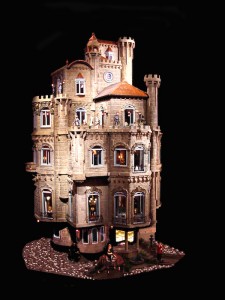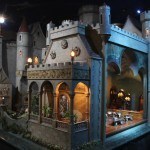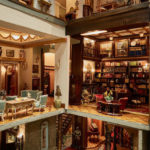Elaine Diehl Master Artisan
Most famous dollhouse miniatures were created at the behest of wealthy patrons or collectors. Colleen Moore’s Fairy Castle, Helena Rubinstein’s Room Boxes and The Catherine Palace commissioned by Carole Kaye, to name a few. The Astolat Castle was created by the artisan herself … with a little help from her friends.
It Began As Therapy
Eliane Diehl was a commercial artist in Sedona, Arizona. After a long day at the drawing board, she found it relaxing to come home and make miniatures. Soon the projects she was designing, building and furnishing grew bigger and more elaborate. People dropped by to see her latest creation. Elaine started selling her work, and she was on her way to becoming a master artisan.
“It’s been a wonderful hobby,” Elaine said. “I used to not be able to wait to get home from works so I could play. The hours slipped by so easily. I would look at my watch and it would be three in the morning. So I would go to bed, just so I could get up and go to work, so I could come home and play again.”
In 1978, after Elaine made a sale for what she described as “a ridiculously high price,” the idea for a castle, which she had been germinating in her imagination for the past four years, made it to the design stage. She worked on it in her home until opening Minielaine’s Miniature store in Sedona in 1981. The castle became the focal point of the shop, just inside the front door, a work in progress that took another six years to complete.
Artisan friends from around the world contributed museum-quality furnishings and accessories the project, which now encompassed seven periods and styles, including Spanish, Oriental, Tudor, 18th Century English and Victorian.
What’s In A Name
At some point, Elaine decided the castle must have a name. She was reading Alfred Lord Tennyson’s epic poem “Idylls Of The King” and came across the line: “Elaine the Fair, Elaine the Lovable, Elaine the Lily Maid of the Astolat.”
Elaine Diehl thought that fitting because she had always wanted to rule over her own domain. “It’s been expressed by miniaturists that with this hobby, you can be in control of your own little world,” she said. “In real life, you don’t have all these choices available to you.”
With this, she waved at the “miniature” structure in the front of her shop, containing thousands of design choices she made. Astolat Castle had grown to 9 feet tall. It weighed between 815 to 890 pounds, depending which of the more than 10,000 décor items are on display at any given time. About two-thirds of the furnishings, most museum quality, are kept in storage. Wouldn’t you love to see an exhibit of the ‘out-takes?’
Favorite Question
Elaine has had many compliments about her creation, but the story she most likes to tell is about a little boy who gazed up at the structure towering above him and asked his mother, “Is this one of those things that if you touch it, you die?”
Elaine Diehl retired in 1991. She sold the Astolat Castle to Lois and Dr. William Freeman of Long Island, New York. They loaned it to the Tee Ridder Miniature Museum where it was exhibited for many years.
Astolat Castle recently concluded one of its rare public exhibitions at the Time-Warner Center at Columbus Circle in New York City. In the tradition of many great dollhouses, the proceeds went to children’s charities — St. Jude’s Children’s Hospital, Autism Speaks, Orphan’s International, and many others.
I compiled this article from many Internet sources. Special thanks to the Prescott (AZ) Courier. You may also be interested in my article on the Astolat Castle.
Susan Downing, with Patrick Owens






